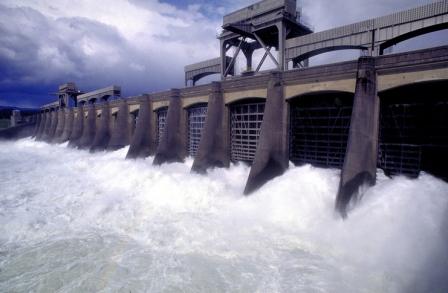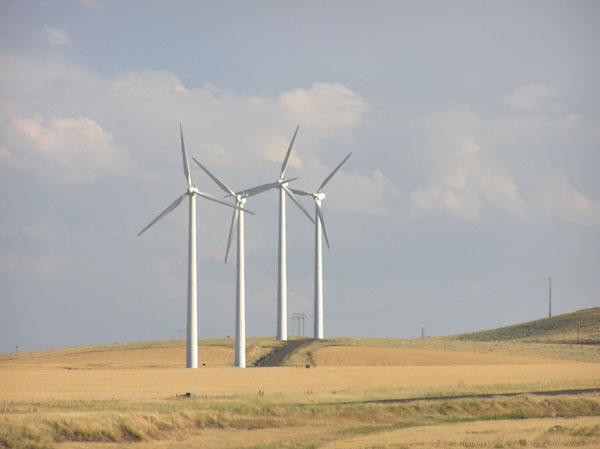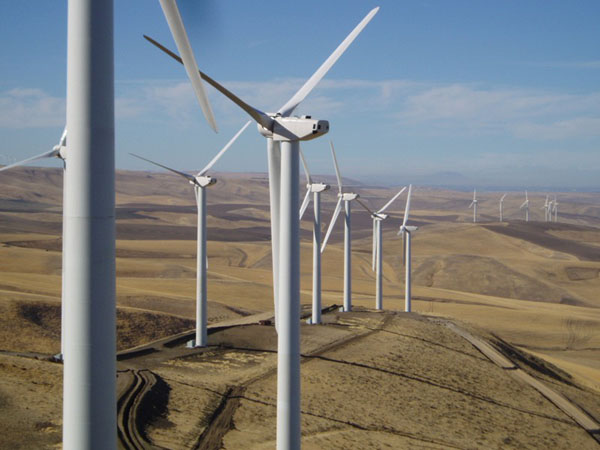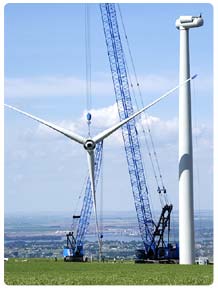On the last day of June, 2008, a surge of wind power caused a spike in the Northwest power grid, making the Bonneville Power Administration realize it could not handle such surges without spilling water that could be potentially dangerous to Columbia River salmon.
The BPA was “caught off guard” when an unexpected increase in wind power overloaded the regional grid. The Bonneville dam compensated by spilling water, keeping it from the hydropower generators. Generally, water is spilled to help juvenile salmon make their way downriver; however, excessive nitrogen, created when water plunging from the dams into the river becomes saturated with air (which is composed of 78% nitrogen), can be harmful to salmon. In this instance the BPA claimed the spill was not heavy enough to damage fish.
At the time of the power surge, BPA power managers began to call the operators of Columbia Basin wind farms with orders to cut their power output. Some calls only reached answering machines; one wind farm operator misunderstood the directive and kept wind generation steady; one wind farm did manage to reduce its power production.
So why is the extra green power a bad thing? After all, one new wind farm in Eastern Oregon will produce enough electricity to light 30,000 homes and will prevent the annual emission of 70,000 tons of carbon dioxide, which is the equivalent of taking 7,000 cars off the road. But the current power grid will not be able to handle all the electricity created when the wind is really blowing and the wind farms are operating at maximum capacity. Even though we presently have enough electricity to meet demand in the Northwest, any excess green power produced here can’t leave the Northwest grid.
The BPA first began connecting wind generation projects to its system in the late 1990s. From that time until the fall of 2005, the peak amount of wind power in the BPA system remained at about 250 megawatts. By December 2005 the peak amount of wind power increased to about 475 megawatts. And by November 2006, actual wind generation on the BPA system surpassed the 1,000 megawatt level for the first time.
The “Wind Integration Plan”, a blueprint for wind energy in the Northwest, calls for even more wind power production by 2009. The crux of the problem we face now is that the power grid is not only incapable of handling power spikes as described here, but the grid’s old design provides no efficient way to move power from one section of the country to another. Also, under current laws, the Federal government has comparatively little authority over power grid regulation, leaving the matter up to each state.
From an August 2008 New York Times article: “The dirty secret of clean energy is that while generating it is getting easier, moving it to market is not.” Today’s grid is basically a system created a century ago to permit utilities to help each other, sharing regional power and reducing blackouts. Currently, the BPA grid provides services to Oregon, Washington, Northern California, Northern Idaho and Western Montana. Beyond these areas, lines are not yet extended to the Midwest or East Coast. Infrastructure has to be built and no new lines have been added in the last 15 years. Suedeen G. Kelly, a member of the Federal Energy Regulatory Commission, says “We need an interstate transmission superhighway system.” Many transmission lines and their interconnections are just too small for the amount of power that utilities would like to send through them.
There are many more issues involved with wind power which we shall review in the future, including: energy storage (“batteries”); load balancing between multiple energy sources; and the fact that the BPA is trying to broker a deal where the wind industry would compensate their greenhouse-gas producing competition (coal and gas-fired electricity plants) for their loss of profits!
Sources:














![Washington State Water Quality Assessment [303(d)] Washington State Department of Ecology](http://www.rosemerena.org/home/wp-content/uploads/2009/03/ecy_logo.gif)

